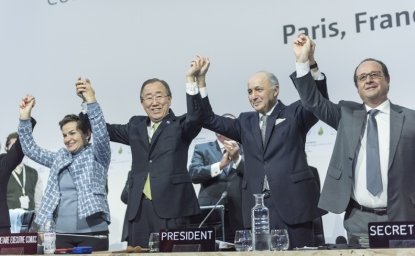Canada is about to show whether federalism facilitates or deters progress in climate governance, because the country’s highly decentralized system of energy development and environmental protection requires the individual provinces to act for the country to meet its national environmental goals.
In previous decades the very notion of relying on provinces, territories, and localities as anything more than bit players in attempting to reduce greenhouse gas emissions was largely dismissed. It yielded to a conventional wisdom that assumed a few nation states would converge and reach a binding international climate deal that would be applied globally.
But nearly two decades after the crafting of the now-discredited Kyoto Protocol on climate change, we live in a very different world. In the recently completed Paris meetings, we see an international strategy that is loosely coupled with individual nation-states pledging reductions while eschewing any binding treaty to assure compliance.
Many of these nations are formal federations (think Canada, the United States, India, Germany, Brazil, Australia) or multi-member partnerships (think European Union). And even unitary systems like China have relied heavily on localized experimentation in attempting to create a cap-and-trade system.
Canada thus emerges as an intriguing test of whether broad national pledges to be a credible global partner can be met largely through a compilation of what individual provinces are prepared to do. Indeed, incoming Prime Minister Justin Trudeau has demonstrated strong rhetorical commitment for Canada to “do more,” but has not been terribly clear about what a federal role might entail, either on the campaign trail or since taking office.
Trudeau’s task is eased by climate policy moves taken before his election by a number of Canada’s biggest provinces. These have created distinctive forms of carbon pricing on opposite geographical ends of the nation. In the west, British Columbia has drawn international praise by creating a carbon tax nearly a decade ago that has endured and demonstrated a cost-effective way to reduce emissions. Alberta’s newly elected government, following the lead of its neighbor, continues to develop its own version of a carbon tax.
In the east, Quebec has emerged as California’s only cap-and-trade partner after three other provinces and seven states jumped ship several years ago. Quebec recently completed its fifth auction of emission allowances with California, enforcing their cap while producing new revenue through competitive bidding. So far, we have seen none of the glitches that have undermined cap-and-trade systems in the European Union and elsewhere. Ontario and Manitoba are now planning to join and thereby expand this cross-national trading system.
So what is a new prime minister to do, other than stand back and see whether these provinces sustain their pledges and whether laggard provinces join in? Three potential challenges emerge:
Infrastructure
Trudeau pledged during the campaign to run short-term deficits to pump revenue into traditional infrastructure—roads and bridges. But any climate and clean energy revolution will require considerable investment to create twenty-first century transmission and storage that spans all of Canada. This includes finding a revenue source to cover costs and share that equitably with competing provinces and territories—always a challenging game in the “where’s mine” battleground of Canadian fiscal federalism. The complexity is only compounded by the vast physical expanse, particularly as localized opposition to siting new wind farms or transmission capacity shows signs of growing. And cross-provincial infrastructure projects have long proven particularly challenging in Canada because it lacks anything like the U.S. constitutional commerce clause, which overcomes state barriers to cooperation.
Delivering convincing benefits
One enormous challenge in climate policy is demonstrating something other than the costs associated with carbon pricing and energy transition. Politics and public opinion tend to respond to near-term costs and benefits rather than aspirations that current sacrifice might benefit future generations. So quite often the initial enthusiasm global climate summits ramp up prove hard to sustain when attention turns to policy particulars back home. There have been no shortage of Canadian and provincial pledges, goals, and targets in prior decades, but most have ultimately been ignored or reversed.
Market-based policies like carbon taxes and cap-and-trade with an auction mechanism impose costs but also produce revenue. Indeed, a brilliant feature of British Columbia’s carbon tax was clear commitment to reduce other taxes in exchange for energy price hikes.
Much the same holds in what may be the world’s best functioning cap-and-trade system, the American Regional Greenhouse Gas Initiative, covering nine Northeastern states—Connecticut, Delaware, Maine, Maryland, Massachusetts, New Hampshire, New York, Rhode Island, and Vermont—which pumps most auction revenue into energy efficiency projects such as insulation and energy audits that directly benefit both residential and commercial electricity consumers. Most carbon pricing experiments in North America and abroad have been markedly less successful in making this linkage.
Credibly demonstrating a cost-and-benefit linkage will be an enormous challenge in other provinces entering carbon pricing strategies. Trudeau will also face this test at a federal level if he attempts to fashion an actual federal carbon price for Canada, even one that might be used to support the kind of infrastructure development noted above. As California is learning, designing a plan for revenue allocation from emission trading auctions years after the launch of the system only adds uncertainty about how funds are best used and who ultimately benefits. To date, fund allocation has regularly changed to include bailouts of the state deficit, support for a controversial high-speed rail system that is decades from completion, and many other endeavors. This serves to expand the line of constituents who see themselves as preferred recipients and are potentially alienated when not rewarded. This may pose a fundamental test for the new prime minister, similar to the one that confounded Barack Obama at the peak of his power more than a half-decade ago: If you commit to raising prices on energy to drive down demand and emissions, who then receives that revenue, who does not, and can government effectively deliver on any promises?
Engaging the United States
The Keystone oil pipeline appears to be history. Where does Canada now go in its relationship with the United States on climate and energy? States and provinces have tried in recent decades to work together on policy but few of these efforts have produced serious agreements or proven durable, with the notable exception of the Quebec-California trading system. Many have largely dissolved after the initial signing ceremony or memorandum of understanding. But the United States is now launching its own massive experiment in climate federalism, via President Obama’s use of Clean Air Act authority to create a Clean Power Plan. This establishes binding emission reductions in the electricity sector over coming decades while giving enormous latitude to individual states to develop their own approach to reaching them.
Trudeau’s campaign rhetoric at times seemed to suggest a possible made-in-Canada version of Obama’s strategy, and some provinces eagerly eye the possibility of expanding hydroelectric exports into the United States. They are also considering the option of emissions trading as partners in the “trading-ready” system that the Administration is encouraging states and regions to develop under the Clean Power Plan, which could potentially accommodate international partners. The new Obama plan, however, is hardly sure of a steady future—more than half of the states are already in federal court trying to reverse the plan in what is being described as the “Super Bowl of environmental litigation.” Moreover, a number of Republican luminaries who gaze into their mirrors and see the face of the 45th president of the United States are not mincing words in declaring that they would make it a priority to try to kill the Clean Power Plan upon taking office in January 2017. Finally, early analysis of American public opinion suggests broad support for state compliance with the new federal policy but far less support for cap-and-trade than other policy options.[1] Trudeau will have to navigate this uncertain terrain and ultimately explain just what kind of a climate and energy partnership he envisions with his neighbor after a near-decade of cross-national energy dialogue dominated by haggling over a single pipeline proposal.
Trudeau is mindful of the experience of his father, Pierre Trudeau, who during his tenure as prime minister was hammered politically for over-extending the federal reach into energy. But every modern Canadian leader has faced the question of building a credible and constructive federal role in energy, now compounded by the linkage to climate change and transition to a lower-carbon imprint. Justin Trudeau, dealt a rather promising hand thanks to new provincial engagement in the West and East, has a unique opportunity to demonstrate that climate federalism can work in delivering timely, cost-effective, and politically-sustainable climate policy that delivers near-term benefits and positions Canada as a model for the world.
The opinions expressed here are solely those of the author.
[1]“American Attitudes about the Clean Power Plan and Policies for Compliance: a report from the National Surveys on Energy and Environment,” Issues in Energy and Environmental Policy, Number 27, December 2015, http://closup.umich.edu/issues-in-energy-and-environmental-policy/27/american-attitudes-about-the-clean-power-plan-and-policies-for-compliance/.
Photo Source: Arctic Sunrise, Len Radin (CC BY-NC-ND 2.0)








